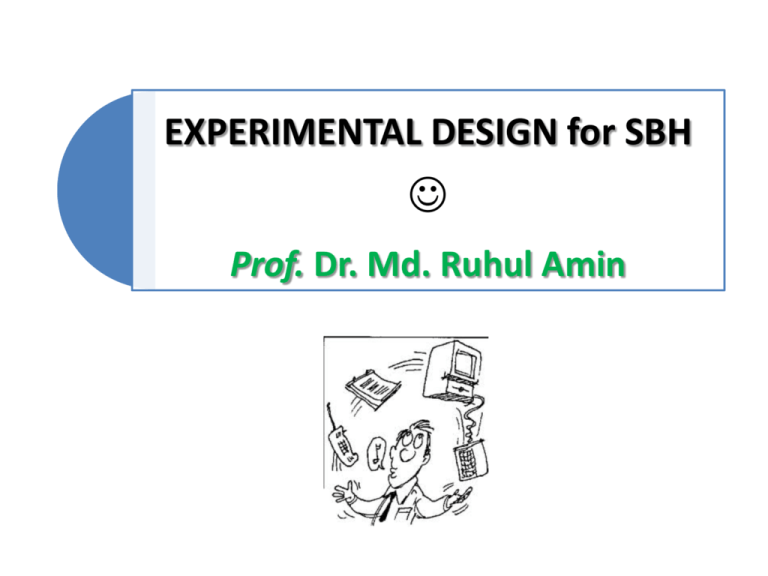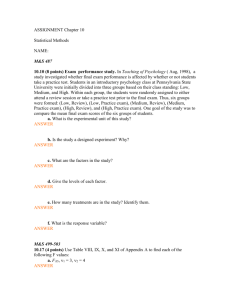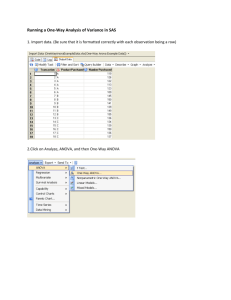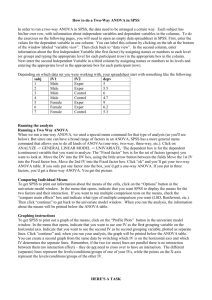EXPERIMENTAL DESIGN for SBH
advertisement

EXPERIMENTAL DESIGN for SBH Prof. Dr. Md. Ruhul Amin What ? Why ? How? EXPERIMENTAL DESIGN The preplanned procedure by which samples are drawn is called EXPERIMENTAL DESIGN Experimental Design Experimental design is a set of rules used to choose samples from populations. The rules are defined by the researcher himself, and should be determined in advance. In controlled experiments, the experimental design describes how to assign treatments to experimental units, but within the frame of the design must be an element of randomness of treatment assignment. It is necessary to define Experimental error Replication Sample units (observations) Experimental units Size of samples Treatments (population) Experimental Design.. Basic Designs 1. Completely Randomized Design (CRD) 2. Randomized Block design (RBD) 3. Latin Square Design CRD is known as “One-way design” Designs commonly used in Animal Science i) One-way design (no interaction effect) a. Fixed effects b. Random effects ii) Factorial design (interaction effect) Some important definitions Treatments : Whose effect is to be determined. For example i)you are to study difference in lactation milk yield in different breeds of cows. ….. Treatment is breed of cows. Breed 1, Breed 2… are levels ii) You intend to see the effect of 3 different diets on the performance of broilers. ….. Treatment is diet and diet1, diet2 and diet3 are levels (1,2,3) …..definitions Experimental units: Experimental material to which we apply the treatments and on which we make observations. In the previous two examples cow and broilers are the experimental materials and each individual is an experimental unit. Experimental error: The uncontrolled variations in the experiment is called experimental error. In each observation of example(i) there are some extraneous sources of variation (SV) other than breed of cow in milk yield. If there is no uncontrolled SV then all cows in a breed would give same amount of milk (!!!). …..definitions Replication: Repeated application of treatment under investigation is known as replication. In the example (i) no. of cows under each breed (treatment) constitutes replication. Randomization: Independence (unbiasedness) in drawing sample. Randomization, replication and error control are three principles of experimental design. Fixed Effects One-way ANOVA 1. Testing hypothesis to examine differences between two or more categorical treatment groups. 3. Measurements are described with dependent variable, and the way of grouping by an independent variable (factor). 2. Each treatment group represents a population. Fixed effects one-way ANOVA • Consider an experiment with 15 steers and 3 treatments (T1, T2, T3) • Following scheme describes a CRD Steer No 1 2 3 4 5 6 7 8 Treatm ent T2 T1 T3 T2 T3 T1 T3 T2 Steer No 9 10 11 12 13 14 15 Treatm ent T1 T2 T3 T1 T3 T2 T1 NB: One treatment appeared 5 times. Equal no. of replication/treatment – not necessary in one-way ANOVA Fixed effects one-way ANOVA.. Data sorted by treatment for RANDOMIZATION T1 T2 T3 Steer Measure Steer ment Measure Steer ment Measure ment 2 6 9 12 15 y11 y12 y13 y14 y15 y21 y22 y23 y24 y25 y31 y32 y33 y34 y35 1 4 8 10 14 3 5 7 11 13 Fixed effects one-way ANOVA.. In applying a CRD or when groups indicate a natural way of classification, the objectives can be 1. Estimating the mean 2. Testing the difference between groups Fixed effects one-way ANOVA.. Model Yij ti eij Where Yij = Observation of ith treatment in jth replication = Overall mean ti = the fixed effect of treatment i (denotes an unknown parameter) eij = random error with mean ‘0’ and variance ‘ 2 ‘ The factor or treatment influences the value of observation Fixed effects one-way ANOVA.. Treatment 1 Treatment 2 Look the difference Fixed effects one-way ANOVA.. Problem 1: An expt. was conducted to investigate the effects of 3 different rations on post weaning daily gains (g) in 3 different groups of beef calf. The diets are denoted with T1, T2, and T3. Data, sums and means are presented in the following table. Fixed effects one-way ANOVA.. T1 T2 T3 270 290 290 300 250 340 280 280 330 280 290 300 270 280 300 Total 1400 1390 1560 n 5 5 5 15 y 280 278 312 290 4350 One-way ANOVA: Hypothesis Null hypothesis Alternative hypothesis Ho: There is no significant difference between the effect of rations on the daily gains in beef calves ie Effects of all treatments are same. Ha: There is significant difference between the effect of rations on the daily gains in beef calves ie Effect of all treatments are not same. Ho: 1 2 3 Ha : 1 2 3 Level of significance or confidence interval Commonly used level of significances α=0.05 • True in 95% cases • p<0.05 α=0.01 • True in 99% cases • p<0.01 p< 0.05, conf. interval = 95% ; p< 0.01, conf. interval = 99% Calculation of different Sum of Squares(SS) y , say Where CF 2 Total SS = y i j 2 ij CF T 0 ij N 2 Treatment SS = yi. CF i n T , say i Error SS = Total SS – Treatment SS = T0-T= E say CF stands for correction Factor One-way ANOVA Table Source of variation Degrees of freedom (df) Treatment k-1 Sum of squares (SS) 2 y T n i i CF Means square (MS) T ' T /( k 1) F T’/E’ i Error N-k T0 –T = E Total N-1 T0 = y E’ = E/(N-k) 2 ij CF If the calculated value of F with (k-1) and (N-k) df is greater than the tabulated value of F with same df at 100α % level of significance, then the hypothesis may be rejected ie the effects of all the treatments are not same. Otherwise the hypothesis may be accepted. (N=Total no of observation, k=no of treatments) One-way ANOVA… 1. Grand Total (GT) = y 2. CF = ( y )2 (4350) i j ij (270 300 ... ... 300) 4350 2 i j ij N 1261500 15 3. Total Corrected SS = y CF (270 300 ... ...300 ) CF 2 i j 2 2 2 ij = 1268700 – 1261500 = 7200 4. Treatment SS = 2 i ( y ij ) j n i 2 2 2 CF 1400 1390 1560 5 5 5 CF 1265140 1261500 3640 5. Error SS = Total SS – Treatment SS = 7200-3640 = 3560 ANOVA for Problem 1. Source SS df MS F Treatment 3640 3-1=2 1820 6.13 Error (residual) 3560 15-3=12 296.67 Total 7200 15-1=14 The critical value of F for 2 and 12 df at α = 0.05 level of significance is F 0.05 (2,12 )= 3.89. Since the calculated F (6.13) > tabulated F or critical value of F(3.89), Ho is rejected. It means the experiments concludes that there is significant difference (p<0.05) between the effect different rations (at least in two) of calves causing daily gain. Now the question of difference between any two means will be solved by MULTIPLE COMPARISON TEST(S). Multiple Comparison among Group Means (Mean separation) There are many tests such as • Least significant difference (LSD) test • Tukey’s W-test • Newman-Keul’s sequential range test • Duncan’s New Multiple Range Test (DMRT) • Scheffe test Multiple comparison: Least Significant Difference(LSD) test LSD compares treatment means to see whether the difference of the observed means of treatment pairs exceeds the LSD numerically. LSD is calculated by s 2 where t is the t r value of Student’s t with error df at 100 % level of significance, s2 is the MS of error and r is the no. of replication of the treatment. For unequal replications, r1 and r2 LSD= t s ( 1 1 ) r r 1 2 Duncan’s Multiple Range Test(DMRT) Duncan (1995) made , the level of significance a variable from test to test. The Least Significant Range (LSR) is defined by k LSR SSR s r The value of significant studentized range (SSR) is given in Duncan (1955). In case, a pair of means differs by more than its LSR, they are declared to be significantly different. Random Effects One-way ANOVA: Difference between fixed and random effect Fixed effect Random effect Small number (finite)of groups or treatment Large number (even infinite) of groups or treatments Group represent distinct populations each The groups investigated are a random with its own mean sample drawn from a single population of groups Variability between groups is not explained by some distribution Effect of a particular group is a random variable with some probability or density distribution. Example: Records of milk production in Example: Records of first lactation milk cows from 5 lactation order viz. Lac 1, Lac production of cows constituting a very 2, Lac 3, Lac 4, Lac 5. large population. One-way ANOVA, random effect Source SS df MS=SS/df Expected Means Square(EMS) Between groups or treatments SSTRT a-1 MSTRT Residual (within groups or treatments) SSRES N-a MSRES For unbalanced cases n is replaced with 2 ni 1 i N a 1 N 2 n T 2 2 Advantages of One-way analysis(CRD) Popular design for its simplicity, flexibility and validity Can be applied with moderate number of treatments (<10) Any number of treatments and any number of replications can be carried out Analysis is straight forward even one or more observations are missing Two-way ANOVA Suppose you intend to study the effectiveness of 3 different types of feed in 4 different strains of hybrid broilers. You need to distribute your treatments (3, feed) in a way so that birds of each of the strains (4, blocks) receive each type of feed. Randomization of the samples are to be ensured in an efficient way. Total no. of records = No. of treatments x No. of Blocks x No. of replication (2 in this case) per treatment (3x4x2=24) You want to know Why doing this kind of expt. ? 1.Effect of type of feed on the final live weight in broilers (treatment effect) 2.Effect of strain on the final live weight in broilers (block effect) 3.Joint effect of feed x strain on the final live weight of broilers ( interaction effect) Two-way ANOVA B L O I C K II S III IV No. 1 (T3) No. 7 (T3) No. 13 (T3) No. 19 (T1) No. 2 (T1) No. 8 (T2) No. 14 (T1) No. 20 (T2) Broiler No. No. 3 (T3) No. 9 (T1) No. 15 (T2) No. 21 (T3) (Treatment) No. 4 (T1) No. 10 (T1) No. 16 (T1) No. 22 (T3) No. 5 (T2) No. 11 (T2) No. 17 (T3) No. 23 (T2) No. 6 (T2) No. 12 (T3) No. 18 (T2) No. 24 (T1) Two-way ANOVA Observations can be shown sorted by treatments and blocks T1 I II III IV y111 y121 y131 Y141 y112 y122 y132 y142 T2 y211 y212 y221 y222 y231 y232 y241 y242 T3 y311 y312 y 321 y322 y331 y332 y341 y342 treatment’ i ‘and block’ j ‘ Treatments yijk indicates experimental unit ‘k’ in Blocks Statistical model in two-way ANOVA y ijk t i t eijk j ij i = 1,…,a; j = 1,…,b; k = 1,….,n Where yijk= observation k in treatment i and block j μ= overall mean ti = effect of treatment i βj = effect of block j tβij = the interaction effect of treatment I and block j eijk = random error with mean 0 and variance Ϭ2 a = no. of treatments; b= no. of blocks; n= no. of obs in each treatment x block combination. Sum of Squares, Degrees of Freedom and Mean Squares in ANOVA Source SS df MS= SS/df Block SSBlk b-1 MSBLK Treatment SSTRT a-1 MSTRT TreatmentxBlock SSTRTXBLK (a-1)(b-1) MSTRTxBLK Residual SSRES ab(n-1) MSRES Total SSTOT abn-1 Example: Two-way design Recall that the objective of the experiment previously described was to determine the effect of 3 treatments (T1, T2, T3) on average daily gain of steers, and 4 blocks were defined. However, in this example 6 animals (3x2) are assigned to each block. Therefore, a total of 4x3x2 = 24 steers were used. Treatments were assigned randomly to steers within block. Example: Two-way design The data are as follows Blocks Treatments I II III IV T1 826 806 864 834 795 810 850 845 T2 827 800 871 881 729 709 860 840 T3 753 773 801 821 736 740 820 835 Two-way: Computations y (826 806 ...... 835) 19426 1. Grand Total = 2. Correction term for the mean = i C ( y )2 i j k abn 3. Total SS= SS TOT ijk y i j k j ijk k 2 19426 15723728.17 24 2 C 826 806 .... .... 835 15775768 15723728.17 2 ijk 2 2 52039.83 4. Treatment SS= SS TRT i ( y )2 j k nb ijk 2 2 2 C 6630 6517 6279 8 8 8 15723728.17 8025.58 Two-way: Computations… 5. Block SS = y ijk jk na j 2 2 2 2 2 C 4785 5072 4519 5050 15723728.17 33816.83 6 6 6 6 6. Interaction SS SS TRTxBLK ( k i j 2 y ijk ) SS TRT (826806) (864871) 2 2 SS BLK C 2 2 (820835) 2 .... .... 2 8025.58 33816.83 15723728.17 8087.42 7. Residual SS = SS RES SS TOT SS TRT SS BLK SS TRTxBLK 2110.00 ANOVA TABLE Source SS df MS Block 33816.83 4-1 = 3 11272.28 Treatment 8025.58 3-1 = 2 4012.79 TreatmentxBlock 8087.42 2x3=6 1347.90 Residual 2110.00 3x4x(2-1)=12 175.83 Total 52039.83 23 F value for treatment : F = 4012.79/175.83 = 22.82 F value for interaction: F = 1347.90/175.83 = 7.67 Conclusion The critical value for testing the interaction is F0.05,6,12 = 3.00, and for testing treatments is F0.05,2,12 = 3.89. So at p = 0.05 level of significance, H0 is rejected for both treatments and interaction. Inference: There is an effect of treatments and the treatment effects are different in different blocks. A practical example of one-way ANOVA Problem: Adjusted weaning weight (kg) of lambs from 3 different breeds of sheep are furnished below. Carry out analysis for i) descriptive Statistics ii) breed difference. Suffolk: 12.10, 10.50, 11.20, 12.00, 13.20, 10.90,10.00 Dorset: 11.50, 12.80, 13.00, 11.20, 12.70 Rambuillet: 14.20, 13.90, 12.60, 13.60, 15.10, 14.70, 13.90, 14.50 Analysis by using SPSS 14 Descriptive Statistics N minimum maximum mean Std. dev suff 7 10.00 13.20 11.4143 1.09153 dors 5 11.20 13.00 12.2400 .82644 ramb 8 12.60 15.10 14.0625 .76520 Valid N (list wise) 5 ANOVA (F test) a) ANOVA Sum of squares df Means Squares F Sig. Between groups 27.473 2 13.736 16.705 .000 Within groups 13.979 17 .822 Total 41.452 19 Mean Separation Post hoc tests Homogenous subsets Wean Duncan 3 N Subset for alpha =0.05 1 2 suff 7 11.414 dors 5 12.240 ramb 8 Sig. 14.063 .121 1.000 Interpretation of results i) Null hypothesis (μ1=μ2=μ3) is rejected ie there is significant (p<0.001) difference in weaning wt. between breeds. ii) Rambuillet has significantly (p<0.05) highest weaning wt. among the 3 breeds and there is no significant difference (p>0.05) between weaning wt.s of Suffolk and Dorset. Do you know Statistics????? You are going to be an Animal Scientist!!!! Booo---- Yes







